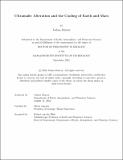| dc.contributor.advisor | Jagoutz, Oliver | |
| dc.contributor.author | Murray, Joshua | |
| dc.date.accessioned | 2024-10-02T17:29:59Z | |
| dc.date.available | 2024-10-02T17:29:59Z | |
| dc.date.issued | 2024-09 | |
| dc.date.submitted | 2024-09-19T16:57:39.240Z | |
| dc.identifier.uri | https://hdl.handle.net/1721.1/157093 | |
| dc.description.abstract | This thesis deals with the influence of `ultramafic' rocks over the climate of planets. Ultramafic rocks, rich in Mg and Fe, are the most common rocks on Earth but exist primarily in the mantle and rarely outcrop on the surface. They are incredibly unstable under Earth's surface conditions where they are altered via incongruent reactions which form clay minerals, iron oxides, and ultimately release cations to the ocean. Due to their instability, they play an out-sized role in Earth's long-term carbon cycle. My first chapter investigates a hitherto unappreciated mechanism by which ultramafic rocks serve as a carbon sink, through the formation of high-surface-area clays and the resultant burial of organic carbon. I use a combination of mineral weathering models and proxy data to show that this mechanism has contributed to the glaciations of the Palaeozoic (541 - 252 Ma).
Unlike Earth, igneous rocks on the Martian surface are frequently of ultramafic composition. My second chapter argues that the alteration of these Martian ultramafic rocks was fundamental in the cooling of the planet from a habitable surface with liquid water to a cold and icy planet, largely devoid of an atmosphere. I show that the same high-surface-area clay minerals which bury organic carbon on Earth are prevalent enough on Mars to store the bulk of its initial 1-4 bar atmosphere as adsorbed methane. I postulate that this methane was formed abiotically during hydrothermal alteration of ultramafic rocks, a process which is observed in ultramafic systems on Earth. I show that this framework reconciles the histories of \dc{} and atmospheric loss-to-space on Mars.
My final chapter quantifies the effects of the alteration of ultramafic and mafic rocks across the Taconic orogeny in Newfoundland, Canada. This collision exposed one of the most well-studied ultramafic bodies on Earth, the Bay of Islands ophiolite, and closely preceded global cooling in the Middle-Late Ordovician (470-445 Ma). I present a new method, leveraging both geochemical analysis and modelling of basin sediments, to infer ancient silicate weathering fluxes. I show that the relative weathering rate in this region increased dramatically during the Taconic orogeny. This method could be applied throughout systems with tectonically-driven changes in surface lithology to build a fuller understanding of the forces which modulate Earth's climate.
My work asks as many questions as it answers but tries to honestly portray the uncertainties associated with the application of quantitative methods in noisy, geologic systems. I hope that in trying to meaningfully constrain these processes I plant seeds of inquiry from which myself and others can one day make more concrete statements of the cause and effect between tectonics and climate. | |
| dc.publisher | Massachusetts Institute of Technology | |
| dc.rights | In Copyright - Educational Use Permitted | |
| dc.rights | Copyright retained by author(s) | |
| dc.rights.uri | https://rightsstatements.org/page/InC-EDU/1.0/ | |
| dc.title | Ultramafic Alteration and the Cooling of Earth and Mars | |
| dc.type | Thesis | |
| dc.description.degree | Ph.D. | |
| dc.contributor.department | Massachusetts Institute of Technology. Department of Earth, Atmospheric, and Planetary Sciences | |
| dc.identifier.orcid | 0000-0003-3487-0613 | |
| mit.thesis.degree | Doctoral | |
| thesis.degree.name | Doctor of Philosophy | |
